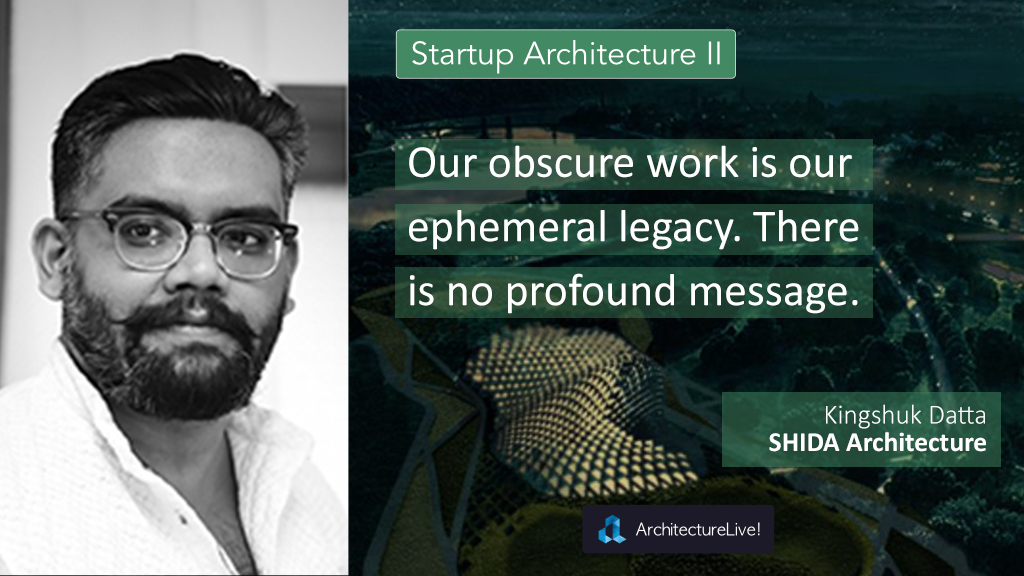SHIDA Architecture is an avant-garde socio-architectural think tank with its origins in India, that started sometime during 2005 at Sir J J College of Architecture, Mumbai. Its main ‘area of concern’ is the possibility of an architecture suited for the emergent consumerism in India post-2020. The practice’s speculative work ranges in scale from envisioning Hyper-Dense Skyscrapers for the near future, University Campuses, Eco Resort Complexes to as small as a Logo for a bespoke gastronomic group in Manhattan. The major emphasis lies on developing a strong contextual identity of the subcontinent through speculative projections. SHIDA is currently based out of New Delhi & London. With its ongoing observations of environments & material- & visual cultures across the world, SHIDA envisions newer generations of contextual identities through architectures across all scales imaginable that soothe, excite and emote with the soul of the builder, the dweller, & the passerby alike. SHIDA seeks to change the current scenario of what seems to be a forever emergent nation, for the better. As a natural extension to his PhD research at the Technische Universitaet Vienna (TUW), Austria; KD is driving his praxis SHIDA to change the current scenario of what seems to be a forever emergent nation, for the better.
It is a fairly common attribute of daydreaming students going through their mid-undergrad crisis in 3rd year, to think of starting their practice, KD says. “Change the world one space at a time and all that. It wasn’t much different for us either.”
Having realized early on that a surname-based practice is irrelevant for the contemporary society, they sliced their surnames off, Harshad Shitole, & Kingshuk ‘KD’ Datta, (both Co-Founders), and made up a word that apparently didn’t mean anything pre-existing in an Indian context (this, KD, feels was super naïve, though). They later realized variations of ‘SHIDA’ mean ‘intensity’ in Arabic, ‘Be Big’ in Mandarin & ‘Trouble’ in Swahili. “So, yes, we are open to lot of mischief making!”
 MOKSLATEITIS: Future-Science – Competition Entry by SHIDA Architecture – More details HERE.
MOKSLATEITIS: Future-Science – Competition Entry by SHIDA Architecture – More details HERE.
“We wanted to keep our work at the edge of the bubble of ‘applied research in architecture’ as much as possible, something that is visibly amiss in the deliberately curated chasms between industry & academia today. This has kept us off-grid from the mainstream, thereby allowing a lot of freedom and room for creative risk-taking. Also, no wonder we haven’t won any major fancy award yet. I want to keep doing cool stuff, keep reinventing our own understanding of architecture. Definitely, it wouldn’t have happened in someone else’s basement, in front of a depressing CAD terminal.”
At the cost of sounding notoriously straight mouthed, KD says that ‘Access’ and ‘Exercising Leverage’ on & off the boardrooms have been the biggest challenges they still face today being a small practice. Every other challenge falls short in front of these, he opines. Also, in the ‘Development-on-Steroids’ scenario since last two decades, not having a godparent hasn’t exactly worked in favor. A godparent usually eases the access to the power corridors. “It’s like starting life, without vaccinations. One just fends throughout the first half-life of their practice. By & by, we all ease in as most of the rest cave in by mid-run.”
Looking around observantly, one would concur this isn’t one bit embellished for publication. Yet, no one even talks about it in the fear of being professionally excommunicated. Most of us aren’t risking enough, and, to empathize with my co-practitioners, with fair reasons of risk aversion. But the good news is, rare few are. We are always so hungry to seek out & collaborate with those disruptors. Over a decade of being in the industry, everyone finds & tucks themselves in their comfort niche, and so did we. And then I got bored, yet again.
Just to test muscle-flexing in a global context, SHIDA has indulged in a number of open international competitions. After Bamiyan Center, Helsinki Guggenheim (ahem!), they participated in a commissioned competition for the National Science & Innovation Center in Lithuania, for which they were adjudged globally 71st (‘… which isn’t much to be honest!’ -KD). The best part in it was knowing that Arup Associates was adjudged 70th. This was a very elating pat on the back. “It meant we have it in us, we have to polish and keep pushing our own notions & capabilities about architecture & then propose it. The competition was done entirely after hours by a team of exhausted but enthused members. I wish we could do the same in Indian competitions, but we all know the scenario here.”
Of late, we have included formulating competition briefs and academic curricula starting with a few young institutes. This allows us to appreciate architecture through a different lens and try to leave a legacy of positive consequence through our work no matter how seemingly inconsequential. When we win that next fancy award, you would anyways know. Then I would pretend to be super busy and up nosed. But that’s for later.
Discussing his plans for SHIDA in the coming years, KD says that the notions of ‘architectural praxis’ is changing at breakneck speed and the global relevance of the Indian architecture is plainly dismal. “We are way off the global discourse and for some weird reason, we are smugly happy not doing anything about anything that occupies the frontiers of the Architectural Applied Research. It’s an Ostrich Syndrome. As a practice, we want to steer ourselves with caution, off this epidemic.”
As a prime focus of his PhD research at the Technische Universitaet Vienna (TUW), Austria; KD is aspiring to bring forth ‘Indo-Futurism’ in the mainstream scene, and not just as a speculative side-gig at the fringes, but rather ‘Built’, in all possible definitions of the word, substantiated by Data-Driven Design Decisions. That being said, it’s easier said than done, but they are at it as we read this!
We are working towards scaling up while staying lean in our processes. We want to keep enabling ourselves to continue to strive bringing bleeding edge applied research to the masses by bypassing the Kafkaesque labyrinth. Five years hence, we would be practicing architecture in ways entirely different than what we did five years ago. And I am convinced that’s moving forward.
In the last 4 years, KD has had the privilege to have been invited to lecture at around 20+ colleges all over India. He always puts forth to all his young friends without fail that its high time students and young mentors take the matter in their hands. Some very inspiring studios and groups are already at it and it is a deeply elating feeling to have known their work & brainstormed with them, he says.
Wrapping up the discussion, he points to a few critical keep-in-your-minds from a list that is continuously getting longer (and this is his 100% unadulterated advice, mind it):
1. Please stop expecting that a fixed curriculum will suffice your entire working career. It simply hasn’t sufficed since last two decades. Don’t wait up for the curricula to change. It won’t. These are way bigger tectonics of which we are all mere participants. And even if it does, it will take at least another 20 to catch up in relevance and by then, the world would have moved far ahead.
2. We live in a post-digital age; the internet is almost everywhere. So naturally, the onus of finding out things lay upon the seeker. Say, if you don’t know how to use an expensive, monopolizing software, then break away from that closed shell of peer-circles & seek out open-source or nominally priced software and learn it online. Don’t expect old professors to spoon feed you on this. They didn’t need it in their career span and that’s that. You need it. So, first, let’s learn ways to keep on learning. (Relax! It applies to me as well).
3. Take as many creative risks as you can. Break some status quo, make sincere mistakes and have the courage to survive through their consequences. But don’t get taken for a ride either.
4. Talk to your friends, esp. the non-architects. Take to non-friends and befriend them. Take notes while you discourse without obsessively trying to establish your personal ‘accurate’ worldview every time.
5. Know your worth. Actual worth. Substantiate your self-assessment by developing your understanding of where the world is, and your place in it. Not a mere delusional idea that as an architect we are the center of the universe. We aren’t. And they know it. You know who.
6. Both being equally valid, it’s still far more honorable to provide free services to an underprivileged person, than, to rot your youth and vigor away slogging for rancid peanuts in a basement, to save up for one Instagramable vacation trip. Think about it.
7. Data is precious. Learn about it. Deploy it in your work. ‘In Data, We Trust.’
8. Practice not seeing yourself as a Superhero, at least not every time. Architecture isn’t a solo male-hero role anymore. Unfortunately, the established processes are such that an ego develops before a portfolio. You would never be the architect that you have come to idolize. Come to think of it as a great boon actually.
9. Your idea is only as good as you present it to the world. An idea in your head is just that, an idea in your head, nothing more. So, communicate. Work, rework & develop your narrative about life as you experience it. Architecture, among its other definitions, is all those settings that allow life to happen.
10. These pointers aren’t absolute in any way, but rather referential observed & curated over time. A decade hence, these will change. So cross check this written piece and see how much of it applies to you.
11. Our obscure work is our ephemeral legacy. In a post-truth world, there is honestly no profound message from above.









